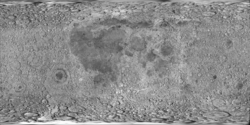Cratere H. G. Wells
| Cratere H. G. Wells | |
|---|---|
| Tipo | Crater |
| Satellite naturale | Luna |
 | |
| Dati topografici | |
| Coordinate | 40°50′24″N 122°37′48″E / 40.84°N 122.63°E40.84; 122.63 Coordinate: 40°50′24″N 122°37′48″E / 40.84°N 122.63°E40.84; 122.63 |
| Maglia | LQ-07 (in scala 1:2.500.000) LAC-30 (in scala 1:1.000.000) |
| Diametro | 109 km |
| Profondità | 2900 m |
| Localizzazione | |
  | |
| Modifica dati su Wikidata · Manuale | |
H. G. Wells è un grande cratere lunare di 108,9 km situato nella parte nord-occidentale della faccia nascosta della Luna, a sud del cratere Millikan, a nord-est del cratere Cantor e a nord-ovest del piccolo cratere Tesla.
È una formazione tra le più antiche come si può dedurre dai numerosi crateri che, oltre a caratterizzare il pianoro centrale, si sovrappongono lungo il bordo, rendendolo fortemente irregolare.
Il cratere è dedicato allo scrittore britannico H. G. Wells.
Crateri correlati
Alcuni crateri minori situati in prossimità di H. G. Wells sono convenzionalmente identificati, sulle mappe lunari, attraverso una lettera associata al nome.
| H. G. Wells | Coordinate | Diametro (in km) |
|---|---|---|
| X[1] | 43°08′24″N 121°23′24″E / 43.14°N 121.39°E43.14; 121.39 (H. G. Wells X) | 27,54 |
Note
- ^ (EN) H. G. Wells X, su Gazetteer of Planetary Nomenclature, United States Geological Survey. URL consultato il 25 aprile 2021.
Bibliografia
- L. E. Andersson e E. A. Whitaker, NASA Catalogue of Lunar Nomenclature, NASA RP-1097, 1982.
- Jennifer Blue, Gazetteer of Planetary Nomenclature, su planetarynames.wr.usgs.gov, USGS, 25 luglio 2007. URL consultato il 5 agosto 2007.
- B. Bussey e P. Spudis, The Clementine Atlas of the Moon, New York, Cambridge University Press, 2004, ISBN 978-0-521-81528-4.
- Elijah E. Cocks e Josiah C. Cocks, Who's Who on the Moon: A Biographical Dictionary of Lunar Nomenclature, Tudor Publishers, 1995, ISBN 978-0-936389-27-1.
- Jonathan McDowell, Lunar Nomenclature, su host.planet4589.org, Jonathan's Space Report, 15 luglio 2007. URL consultato il 24 ottobre 2007.
- D. H. Menzel, M. Minnaert, B. Levin, A. Dollfus e B. Bell, Report on Lunar Nomenclature by the Working Group of Commission 17 of the IAU, in Space Science Reviews, vol. 12, n. 2, 1971, pp. 136–186, Bibcode:1971SSRv...12..136M, DOI:10.1007/BF00171763.
- Patrick Moore, On the Moon, Sterling Publishing Co., 2001, ISBN 978-0-304-35469-6.
- Fred W. Price, The Moon Observer's Handbook, Cambridge University Press, 1988, ISBN 978-0-521-33500-3.
- Antonín Rükl, Atlas of the Moon, Kalmbach Books, 1990, ISBN 978-0-913135-17-4.
- Rev. T. W. Webb, Celestial Objects for Common Telescopes, 6th revised, Dover, 1962, ISBN 978-0-486-20917-3.
- Ewen A. Whitaker, Mapping and Naming the Moon, Cambridge University Press, 1999, ISBN 978-0-521-62248-6.
- Peter T. Wlasuk, Observing the Moon, Springer, 2000, ISBN 978-1-85233-193-1.
- Rachel Alexander, Myths, Symbols and Legends of Solar System Bodies, New York, Springer, 2015, ISBN 9781461470670.OCLC 894554101[1]
Altri progetti
Altri progetti
- Wikimedia Commons
 Wikimedia Commons contiene immagini o altri file su H. G. Wells
Wikimedia Commons contiene immagini o altri file su H. G. Wells
Collegamenti esterni
- (EN) Cratere H. G. Wells, su Gazetteer of Planetary Nomenclature, United States Geological Survey.

- (EN) Immagini del Cratere H. G. Wells, in Atlante fotografico orbitale della Luna, Lunar and Planetary Institute.
V · D · M | ||
|---|---|---|
| Formazioni geologiche | Albedo · Catenae · Crateri · Dorsa · Fossae · Lacūs · Maria · Montes · Oceani · Paludes · Planitiae · Promontoria · Rimae · Rupēs · Stationes · Sinūs · Valles |  |
| Voci correlate | Luna · Esogeologia · Faccia visibile della Luna · Faccia nascosta della Luna | |
 Portale Sistema solare: accedi alle voci di Wikipedia sugli oggetti del Sistema solare
Portale Sistema solare: accedi alle voci di Wikipedia sugli oggetti del Sistema solare- ^ (EN) Rachel Alexander, Craters, Dragons, Festivals, Gods and Goddesses of Earth's Moon, in Myths, Symbols and Legends of Solar System Bodies, New York, Springer, 2015, ISBN 9781461470670. URL consultato il 25 marzo 2017.










